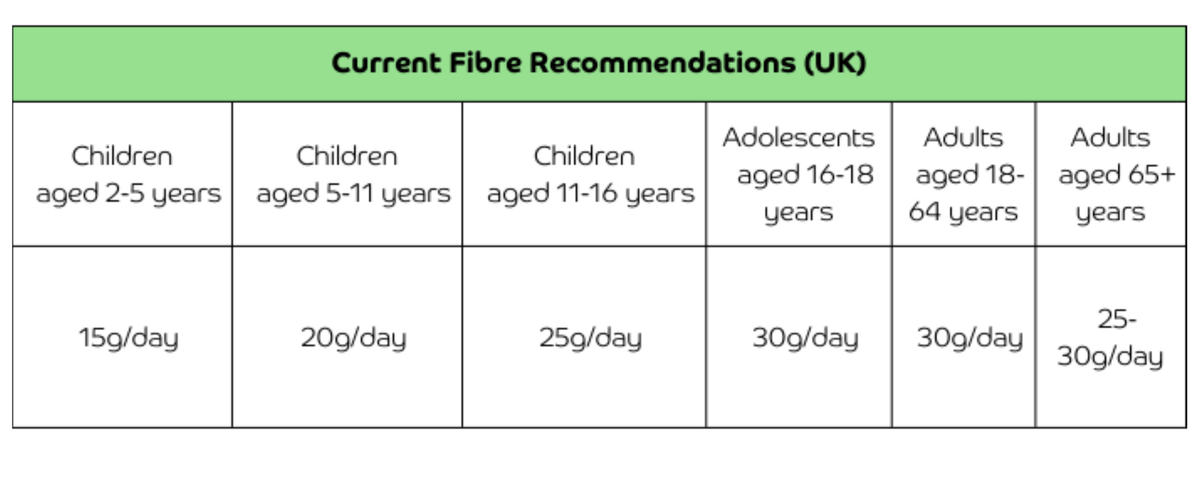Bridging the Fibre Gap: A Look at Dietary Health
The past decade has seen an increase in the number of public health campaigns in the UK aiming to increase dietary fibre consumption. Whilst efforts have been made to improve fibre intake, many adults fail to meet the recommended daily intake of 30g, meaning a so-called “fibre gap” still remains.
The Importance of Fibre
Fibre plays an important role in health and supports the optimal functioning of the digestive tract by improving stool regularity and encouraging a more diverse gut microbiota, and low fibre intakes are associated with an increased risk of constipation, diverticulitis and, in what is currently a worrying upward trend, particularly in young people, a higher likelihood of bowel cancer (Arayici et al., 2021).
Current statistics for fibre intakes from the last National Diet and Nutrition Survey revealed that fibre intakes across all age and sex groups were below the current recommendations; average daily intakes for children were 15.7g in those aged 2-10 years and 15.8g in those aged 11-18 years, and in adults 18g for those aged 18-64 years and 19.1g in those 65 years and over¹. Compared to previous assessments, average daily intakes were also lower; by 2.1g in adults aged 18-64 years and 1.9g in those aged 65 years and over (Office for Health Improvement and Disparities., 2021).
Barriers to Fibre Consumption
Whilst there is much to be done to improve nationwide fibre intake, especially when considering the rapidly increasing prevalence of conditions that correlate with fibre consumption, it is clear that many significant barriers exist. The recent cost of living crisis further reinforces these barriers as dietary quality is compromised, and food becomes less affordable.
Addressing the Gap with Prebiotic Fibre
The current recommendations for fibre (below) include prebiotic fibre. Prebiotic fibre has been shown to act as a food source for beneficial bacteria and as such can support a more favourable composition of the gut microbiota (ISAPP., 2018). Bimuno, a leading provider of prebiotic fibre, offers a unique solution with its Galactooligosaccharides (GOS) formulation, scientifically proven to stimulate the growth of bifidobacteria. With 2g of fibre per serving, Bimuno contributes significantly to daily fibre goals, aligning with recommendations for all age groups.
Taking place every year, Fibre February is a time to support your patients in improving their understanding of the importance of dietary fibre and in finding solutions to help them incorporate long-term, sustainable changes to reach the current recommendations for fibre. At Bimuno, we have patient resources free to download and share with your patients, you can find them here.
In conclusion, Fibre February serves as a timely reminder of the critical role that dietary fibre plays in overall health and well-being. By leveraging educational initiatives and innovative solutions like Bimuno, we can collectively bridge the fibre gap and pave the way for a healthier future.
References
Arayici, M.E., Mert-Ozupek, N., Yalcin, F., Basbinar, Y. and Ellidokuz, H. (2021). Soluble and Insoluble Dietary Fiber Consumption and Colorectal Cancer Risk: A Systematic Review and Meta-Analysis. Nutrition and Cancer, [online] pp.1–14. Available at: https://www.tandfonline.com/doi/abs/10.1080/01635581.2021.2008990.
British Nutrition Foundation (2021). Fibre - British Nutrition Foundation. [online] www.nutrition.org.uk. Available at: https://www.nutrition.org.uk/healthy-sustainable-diets/starchy-foods-sugar-and-fibre/fibre/?level=Health%20professional.
ISAPP (2018). Prebiotics. [online] International Scientific Association for Probiotics and Prebiotics (ISAPP). Available at: https://isappscience.org/for-scientists/resources/prebiotics/ [Accessed 19 Oct. 2023].
Office for Health Improvement and Disparities (2021). National Diet and Nutrition Survey: Diet, nutrition and physical activity in 2020. [online] Available at: https://assets.publishing.service.gov.uk/media/614b16c8d3bf7f71919a7f47/Follow_up_stud_2020_main_report.pdf.


